WHAT'S NEW ACROSS THE WORLD
What's
new April 2000
What's
new July 2000
What's
new October 2000
What's
new January 2001
What's
new April 2001
What's
new July 2001
| What's New ©by
Laif DeMason
As the doldrums of summer wane, interesting cichlids
are again appearing in the market place. Cichlids from Lake Tanganyika
are enjoying a major spurt in availability based on exports from Congo,
Tanzania, and Zambia. Malawi cichlids are holding their own, although
exports have not maintained an edge in sales over domestic sources, as
they have in the past. The rainy season is on in West Africa thus
slowing collections, while South American exports are on a seasonal rise.
It would appear from the sales in the specialty cichlid market that hobbyists
are returning to aquariums in greater numbers and spending more time with
their fishy pets. However, demand drives the cichlid business; thus
if sales prove lucrative, exporters will continue to venture further to
satisfy importers and customers alike.
Here’s “what’s new” on the cichlid scene: |
Lake Tanganyika
Exports from the Congo (west) coast of Lake Tanganyika have arrived
again after several years of restrictions due to political strife.
This stimulus alone has charged up Tanganyika enthusiasts! Further,
regular shipments from the Kipili area of Tanzania have arrived.
In Zambia increased efforts plus additional exporters have sought to make
hard-to-get specimens more available.
|
what's new: Lake Tanganyika
|
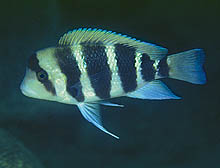
Exported from Congo, the Cyphotilapia frontosa
caught around the islands near Kavala is known for the yellow in its dorsal
fin. Photo by A. Konings. |
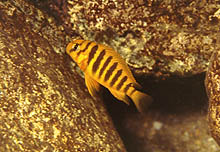
Collected from Ulwile Island near Kipili (Tanzania),
this juvenile Tropheus sp. “Kipili” is also known by more colorful
names. |
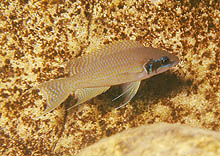
Available throughout the Kipili area, this Lamprologus
brichardi variety sports blue facial markings. |
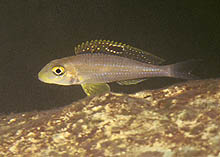
Also in demand is Xenotilapia papilio from
the islands around Kipili. |
Lake Malawi
Juveniles of Malawi cichlids continue to be big sellers. However,
imports of wild-caught fish have slowed due to weak demand. Exports
from both the Malawian and Tanzanian coasts continue, but activity in Mozambique
is very restricted.
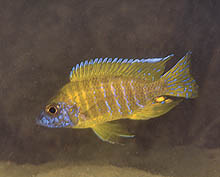
Domestic sources are now supplying F1 adults from
Aulonocara sp. “maleri” from Maleri Island due to its infrequent
collection and export. |

Caught far south in Undu Point (Tanzania) and sold
as Copadichromis sp. “azureus white cap” is a popular fish due to
its striking colors. Photo by A. Konings. |
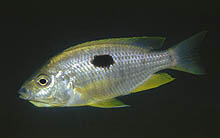
Sporting striking yellow finnage, Copadichromis
pleurostigma is infrequently exported from northern Tanzania.
Photo by A. Konings. |
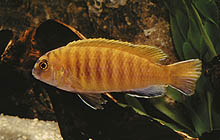
Another Tanzanian export, Tropheops sp. “red
fin” is from Hongi Island. |
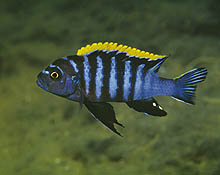
Collected at Hai Reef (Tanzania) this Cynotilapia
afra “red top” is truly a dwarf species. Photo by A. Konings. |
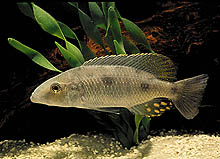
Incidental in the lake, Stigmatochromis pholidophorus
is an example of a beautiful predator species, if one only has the patience
to let it color up in the aquarium! |
Victoria
Victorian cichlid fans have little hope for new wild-caught material
any time soon. Searches are still on-going for the once commonly-bred
varieties that have slipped away from the hobby. With commercial
demand lacking, breeders have discontinued production of several
species. The need to preserve as many direct lineages as possible
becomes even more evident.
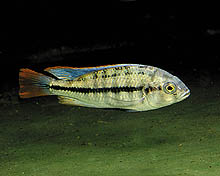
Once commonly bred over five years ago, Astatotilapia
sp. “blue neon” is now rarely seen. |
 One of the most colorful cichlids, ‘Haplochromis’ sp. “all red”
originally hails from Lake Nawampasa.
One of the most colorful cichlids, ‘Haplochromis’ sp. “all red”
originally hails from Lake Nawampasa. |
Neotropics
Neotropical cichlid hobbyists continue to trade bred items from both
South and Central America. Wild supplies continue to flow from the
usual South American countries. Dwarf Apistogramma have gained
popularity due to the ever increasing flow from bred sources in eastern
Europe.
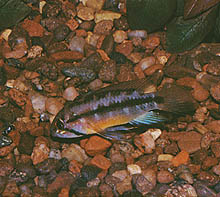
Often imported from Guyana and sold as Apistogramma
ortmanni, this fish is a regular item for dealers. |
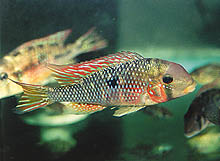
Originally from southern Brazil, Gymnogeophagus
labiatus is gaining popularity among eartheater fans. Photo by
J. Rapps. |
|











 One of the most colorful cichlids, ‘Haplochromis’ sp. “all red”
originally hails from Lake Nawampasa.
One of the most colorful cichlids, ‘Haplochromis’ sp. “all red”
originally hails from Lake Nawampasa.
